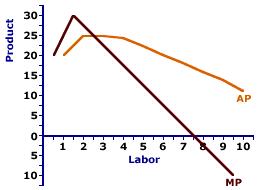
|
|
AAUP: The abbreviation for American Association of University Professors, which is an association of university and college faculty established in 1915 to protect academic freedom. The AAUP is the closest thing university faculty have to a labor union. While it does engage in some collective bargaining functions with specific universities, similar to traditional labor unions, its primary function is to ensure that faculty maintain intellectual or academic freedom from political of social pressures.
Visit the GLOSS*arama
|
|


|

|
                           AVERAGE PRODUCT AND MARGINAL PRODUCT: A mathematical connection between average product and marginal product stating that the change in the average product depends on a comparison between the average product and marginal product. If marginal product is less than average product, then average product declines. If marginal product is greater than average product, then average product rises. If marginal product is equal to average product, then average product does not change. The relation between average product and marginal product is one of several that reflect the general relation between a marginal and the corresponding average. The general relation is this:- If the marginal is less than the average, then the average declines.
- If the marginal is greater than the average, then the average rises.
- If the marginal is equal to the average, then the average does not change.
This general relation surfaces throughout the study of economics. It also applies to average and marginal cost, average and marginal revenue, average and marginal propensity to consume, and well, any other average and marginal encountered in economics.Making Tacos| Average and Marginal Product |  |
The graph at the right for the hourly production of Super Deluxe TexMex Gargantuan Tacos (with sour cream and jalapeno peppers) illustrates the relation between average product and marginal product.The Law of Diminishing Marginal ReturnsThis average-marginal relation for production is closely tied to the law of diminishing marginal returns. Marginal product declines with the onset of diminishing marginal returns. The "hump shape" of the marginal product curve reflects first increasing marginal returns then decreasing marginal returns.For this reason, the "hump shape" of the average product curve is attributable, indirectly, to the law of diminishing marginal returns and the "hump shape" of the marginal product curve. Increasing marginal returns means marginal product is rising and because average product necessarily starts at zero (zero production means zero average product), marginal product lies above average product and causes it to rise, as well. With the onset of decreasing marginal returns, marginal product declines. However, for this initial part of the marginal product decline, average product continues rising because marginal product is still greater. After marginal product falls enough to meet up and intersect average product, average product peaks. As marginal product, again guided by the law of diminishing marginal returns, continues to decline and falls below average product. This causes the decline of average product. In essence, the average product curve plays catch-up to the marginal product curve, sort of follow the leader. At first, marginal product rises, so average product tags along like an annoying younger sibling. Then marginal product decides to fall, so average product chases after it. Because marginal product is guided by the law of diminishing marginal returns, so too is average product.

Recommended Citation:AVERAGE PRODUCT AND MARGINAL PRODUCT, AmosWEB Encyclonomic WEB*pedia, http://www.AmosWEB.com, AmosWEB LLC, 2000-2025. [Accessed: July 18, 2025].
Check Out These Related Terms... | | | |
Or For A Little Background... | | | | | | | | | | |
And For Further Study... | | | | | | |
Search Again?
Back to the WEB*pedia
|



|

|
WHITE GULLIBON
[What's This?]
Today, you are likely to spend a great deal of time searching the newspaper want ads seeking to buy either an extra large beach blanket or a large flower pot shaped like a Greek urn. Be on the lookout for fairy dust that tastes like salt.
Your Complete Scope
This isn't me! What am I?
|

|
|
General Electric is the only stock from the original 1896 Dow Jones Industrial Average remaining in the current index.
|

|
|
"A winner is someone who recognizes his God-given talents, works his tail off to develop them into skills, and uses those skills to accomplish his goals. " -- Larry Bird, basketball player
|

|
AMB
Adjusted Monetary Base
|

|
|
Tell us what you think about AmosWEB. Like what you see? Have suggestions for improvements? Let us know. Click the User Feedback link.
User Feedback
|


|


